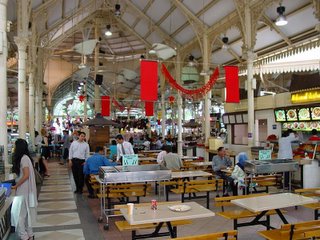Sure, we Singaporeans think that we know our food and are proud of our eating culture, but what exactly helped form this eating culture that we so often indulge ourselves in? While we always talk about the variety of food that we can boast of and the culinary skills of many chefs, we have neglected an important part of our food culture- the structure of our eating places.
Dining places in Singapore have a common feature that all Singaporeans take for granted because of their abundance- the tables. Round or square, they easily seat four to ten persons during a single mealtime. To us, there may appear to be nothing special about such a characteristic since most of us have been brought up in a time when all of these were already in existence. Only the older generation would have witnessed the transformation of Singapore’s eating places, from roadside hawkers to the many hawker centres and restaurants which provide comfortable seating. Gone are the days where people had to squat by the roadside in an unglamourous fashion slurping their ten cents’ worth of noodles.

Rectangular dining tables in Lau Par Sat
Round tables are in essence the key tool in most of our social gatherings. Round tables are more than just a piece of furniture with utilitarian value, but form much of what the Singaporean food culture is based on. This very feature allows people to sit in a way such that nobody is left out and everyone can participate in the conversation. The round table is a classic piece of furniture that allows a relatively large group of people to be seated together during any meal time. Under such a circumstance, it would be unlikely that anyone would be left out in a corner, as in the case of the more angular tables. We see these in many hawker centres and Chinese restaurants where the atmosphere is light and plenty of conversations are taking place amidst the clanging of utensils being washed and the occasional sounds of utensils dropping. Undoubtedly, the round table has served to encourage socialising rather than inhibit it.
 Round tables in a typical Chinese restaurant
Round tables in a typical Chinese restaurant
Still, I am not saying that square or rectangle tables inhibit the socialising process. Here in Singapore, we are more likely to find such tables in non-Asian restaurants. These also promote socialising, but on a smaller scale. Such tables are more intimate since they usually cater to two or four diners, as in the case of fine-dining restaurants for culinary experts, places for discussing business deals or a romantic candlelight dinner for two.
In contrast, our American counterparts have a very different dining experience. Many of their restaurants have bar counters where people can simply eat and leave. This is something that we can hardly find here. This serves to explain why dining out is not an event many Americans deem 'sociable'. Of course, we can also look at it that with the vast amount of space that the US has, travelling just to dine out would be far too troublesome and so they stay home and share their meals. Well, there are always exceptions, seeing how sitting in fornt of the television eating out of 'dinner boxes' has also become a common affair. It is now more explicit why we dine the way we do in Singapore. Our largely Asian culture sets in place the need to eat together so much so that we value the concept of eating together at the table and even take this culture along with us out of our homes and into dining places. The structure of our eating places continues to promote this common value that we all share.
 Round tables in a hawker centre
Round tables in a hawker centre
We cannot deny that mealtimes here are a social affair. If all we had were bar counters then conversations would be few and far between. Judging by all the noise we generate through incessant chatter over meal times, it is far too obvious that discourses at the dining table are something that we cannot do without. This, with the exception of far too conservative families who believe that meal times should be just an eating affair to nourish the bodies and nothing more. Surely that belittles the significance of eating at the dining table, would it not?
I never thought that the structure of our dining places would actually help formulate the Singapore food culture this much until now. It is not something that we would take into consideration on an ordinary basis but rather something that has been taken for granted for a time too long.

0 Komentar untuk "What's With That Shape?"